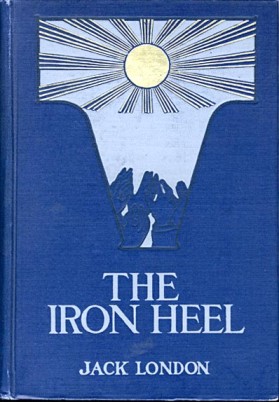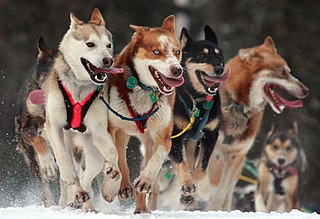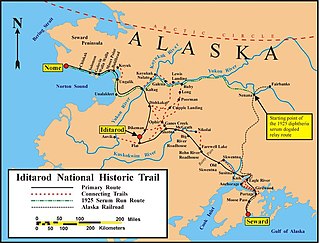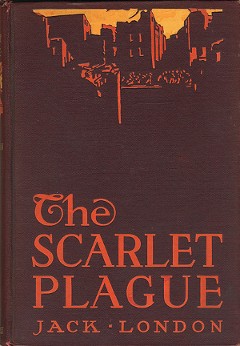Related Research Articles

John Griffith Chaney, better known as Jack London, was an American novelist, journalist and activist. A pioneer of commercial fiction and American magazines, he was one of the first American authors to become an international celebrity and earn a large fortune from writing. He was also an innovator in the genre that would later become known as science fiction.

A sled dog is a dog trained and used to pull a land vehicle in harness, most commonly a sled over snow.

The Chinook is a breed of sled dog, developed in the state of New Hampshire during the early 20th century. The Chinook is New Hampshire's official state dog.

The Call of the Wild is a short adventure novel by Jack London, published in 1903 and set in Yukon, Canada, during the 1890s Klondike Gold Rush, when strong sled dogs were in high demand. The central character of the novel is a dog named Buck. The story opens at a ranch in Santa Clara Valley, California, when Buck is stolen from his home and sold into service as a sled dog in Alaska. He becomes progressively more primitive and wild in the harsh environment, where he is forced to fight to survive and dominate other dogs. By the end, he sheds the veneer of civilization, and relies on primordial instinct and learned experience to emerge as a leader in the wild.

A Daughter of the Snows (1902) is Jack London's first novel. Set in the Yukon, it tells the story of Frona Welse, "a Stanford graduate and physical Valkyrie" who takes to the trail after upsetting her wealthy father's community by her forthright manner and befriending the town's prostitute. She is also torn between love for two suitors: Gregory St Vincent, a local man who turns out to be cowardly and treacherous; and Vance Corliss, a Yale-trained mining engineer.

The Iron Heel is a political novel in the form of science fiction by American writer Jack London, first published in 1908.

Husky is a general term for a dog used in the polar regions, primarily and specifically for work as sled dogs. It refers to a traditional northern type, notable for its cold-weather tolerance and overall hardiness. Modern racing huskies that maintain arctic breed traits represent an ever-changing crossbreed of the fastest dogs.

Balto was an Alaskan husky and sled dog belonging to musher and breeder Leonhard Seppala. He achieved fame when he led a team of sled dogs driven by Gunnar Kaasen on the final leg of the 1925 serum run to Nome, in which diphtheria antitoxin was transported from Anchorage, Alaska, to Nenana, Alaska, by train and then to Nome by dog sled to combat an outbreak of the disease.

White Fang is a novel by American author Jack London (1876–1916) — and the name of the book's eponymous character, a wild wolfdog. First serialized in Outing magazine between May and October 1906, it was published in book form in October 1906. The story details White Fang's journey to domestication in Yukon Territory and the Northwest Territories during the 1890s Klondike Gold Rush. It is a companion novel to London's best-known work, The Call of the Wild (1903), which is about a kidnapped, domesticated dog embracing his wild ancestry to survive and thrive in the wild.

Mushing is a sport or transport method powered by dogs. It includes carting, pulka, dog scootering, sled dog racing, skijoring, freighting, and weight pulling. More specifically, it implies the use of one or more dogs to pull a sled, most commonly a specialized type of dog sled on snow, or a rig on dry land.

White Fang is a 1991 American Northern period adventure drama film directed by Randal Kleiser, starring Ethan Hawke, Klaus Maria Brandauer and Seymour Cassel. Based on Jack London's 1906 novel White Fang, it tells the story of the friendship between a young Klondike gold prospector and a wolfdog. White Fang is portrayed by a wolfdog, Jed, who also appeared in such films as The Thing (1982) and The Journey of Natty Gann (1985). The film was released on January 18, 1991, by Buena Vista Pictures. A sequel to the film, White Fang 2: Myth of the White Wolf, was released in 1994.

The Yukon Quest, formally the Yukon Quest 1,000-mile International Sled Dog Race, is a sled dog race scheduled every February since 1984 between Fairbanks, Alaska, and Whitehorse, Yukon, switching directions each year. Because of the harsh winter conditions, difficult trail, and the limited support that competitors are allowed, it is considered the "most difficult sled dog race in the world", or even the "toughest race in the world"—"even tougher, more selective and less attention-seeking than the Iditarod Trail Sled Dog Race." The originator envisioned it as "a race so rugged that only purists would participate."

The 1925 serum run to Nome, also known as the Great Race of Mercy and The Serum Run, was a transport of diphtheria antitoxin by dog sled relay across the US territory of Alaska by 20 mushers and about 150 sled dogs across 674 miles (1,085 km) in 5+1⁄2 days, saving the small town of Nome and the surrounding communities from a developing epidemic of diphtheria.

The Sakhalin Husky is a critically endangered landrace and sled laika associated with Sakhalin Island and adjacent areas. They are also known Karafuto Ken, Sakhalin Laika, or Gilyak Laika. While bred primarily as a sled dog, Sakhalin Huskies are also used for hunting bear and fishing. In 1989, there were approximately 20 Sakhalin Huskies remaining on Sakhalin Island.

The Northern or Northwestern is a genre in various arts that tell stories set primarily in the late 19th or early 20th century in the north of North America, primarily in western Canada but also in Alaska. It is similar to the Western genre, but many elements are different, as appropriate to its setting. It is common for the central character to be a Mountie instead of a cowboy or sheriff. Other common characters include fur trappers and traders, lumberjacks, prospectors, First Nations people, settlers, and townsfolk.

The Scarlet Plague is a post-apocalyptic fiction novel by American writer Jack London, originally published in The London Magazine in 1912. The book was noted in 2020 as having been very similar to the COVID-19 pandemic, especially given London wrote it at a time when the world was not as quickly connected by travel as it is today. However unlike COVID-19, in this story, victims died within an hour and mortality was practically 100%.

"The Red One" is a short story by Jack London. It was first published in the October 1918 issue of The Cosmopolitan, two years after London's death. The story was reprinted in the same year by MacMillan, in a collection of London's stories of the same name.

The Call of the Wild: Dog of the Yukon is a 1997 Canadian film. The screenplay by Graham Ludlow is based on Jack London's classic 1903 novel The Call of the Wild, and is narrated by Richard Dreyfuss and stars Rutger Hauer.
Charlie Biederman was a musher in Alaska best known for being the last surviving dog sled mail carrier in the United States. Charlie was born in Alaska as the son of Ed Biederman, a musher born in Bohemia who immigrated to the United States in 1874 and also delivered the mail via dog sled. The date of Charlie's birth is unclear, but contemporary U.S. Censuses indicate it likely was around 1919. Charlie had four siblings. Charlie was raised in Eagle, Alaska, but lived in an isolated cabin on the Yukon River for most of his life. From an early age, he assisted his father and brother in their winter deliveries of the mail to isolated cabins in central Alaska. In winter, the family lived in Eagle and ran the mail route between that town and Circle, another small settlement approximately 158 miles (254 km) downriver. In the summer, the family lived at their Yukon River cabin, harvesting fish for subsistence and boarding the dogs of fellow mushers. In 1938, the family were underbid for the main contract for mail delivery in the area by a bush pilot. Ed Biederman retired shortly afterward and died in 1945. The final dog sled mail route was replaced in 1963. That final route was from Gambell to Savoonga and was run by Chester Noongwook. In January 1995, he donated the mail-delivery sled he used to the National Postal Museum in Washington, D.C., where it hangs today. One month after making the delivery, he died on February 22, 1995.

The Son of the Wolf is a 1922 American silent Western film directed by Norman Dawn and starring Edith Roberts, Wheeler Oakman and Sam Allen. It is a northern set in Canada's Yukon and is based on a short story of the same name by Jack London.
References
- ↑ Earle Labor (1961). Jack London's Literary Artistry: A Study of His Imagery and Symbols in Relation to His Themes. University of Wisconsin--Madison.
- ↑ Rebecca Stefoff (4 April 2002). Jack London: An American Original (Oxford Portraits). Oxford University Press. pp. 58–. ISBN 978-0-19-512223-7.
- ↑ Leonard Cassuto; Jeanne Campbell Reesman (1998). Rereading Jack London. Stanford University Press. pp. 127–. ISBN 978-0-8047-3516-2.
- ↑ Blanche H. Gelfant; Lawrence Graver (1 April 2004). The Columbia Companion to the Twentieth-Century American Short Story. Columbia University Press. pp. 343–. ISBN 978-0-231-11099-0.
- 1 2 Alex Kershaw (20 August 2013). Jack London: A Life. St. Martin's Press. pp. 82–. ISBN 978-1-4668-5169-6.
- ↑ Carolyn Johnston (1984). Jack London--an American Radical?. Greenwood Press. ISBN 978-0-313-24464-3.
- ↑ John Perry (October 1981). Jack London, an American myth . Nelson-Hall. ISBN 978-0-88229-378-3.
- ↑ Leonard Cassuto; Jeanne Campbell Reesman (1998). Rereading Jack London. Stanford University Press. pp. 255–. ISBN 978-0-8047-3516-2.
- ↑ Gay Salisbury; Laney Salisbury (17 February 2005). The Cruelest Miles: The Heroic Story of Dogs and Men in a Race Against an Epidemic. W. W. Norton. pp. 279–. ISBN 978-0-393-07621-9.